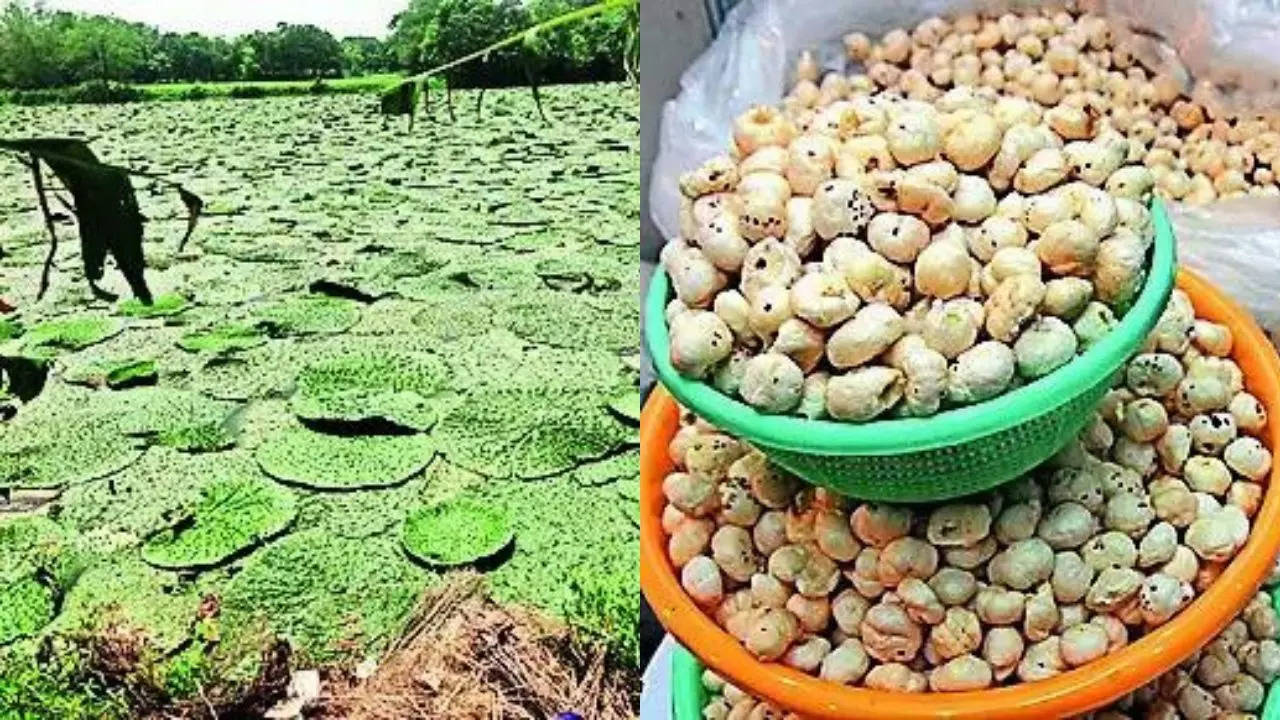How this ‘super food’ can turn fortune of Mithilanchal farmers | Patna News – Times of India

MADHUBANI: Makhana (fox nut), which costs Rs 600-700 per kg in the local markets and up to Rs 1,000-1,500 per kg in metro cities, ordinarily fetches just Rs 200 per kg to the cultivator. Albeit, its new-found status of a “super food” has bolstered demands even internationally, priced at not less than US $100 (about Rs 8,300) per kg.
This traditional aquatic product of Madhubani, having a geographical indication (GI) tag, has the potential to transform the the fortunes of the cultivators, yet it remains an elusive dream.
Historically cultivated alongside fish in ponds and wetlands, makhana cultivation got a boost during the era of Darbhanga Raj. With the state and central govts exhibiting interest in its cultivation and ICAR establishing a Makhana Research Centre in Darbhanga, the cropped area is on rise. But the producers do not get returns commensurate with their investment and they are yet to reap its benefits.
Among various reasons is their dependence on big traders for finances, according to the people in the know. The traders finance the fishermen only after reaching an understanding on price of the nuts, and after processing, sell at a much higher rate, says Anil Sahani of Pandaul block in Madhubani. The difference between the rate of nuts and finished product ordinarily remains around Rs 300 per kg, he claims.
Independent MLC from Darbhanga Graduates constituency, Sarvesh Kumar, says that unless the cultivators are freed from the clutches of the traders by providing them with finances through banks on easy terms and the govt facilitates adoption of technology for processing the nuts, the fishermen will not get benefits.
A cultivator, Manoj Sahni of village Birsair under Rahika block of the district, rues the ICAR also needs to simplify the process of providing improved seeds to them for better produce, and in turn, a decent price. Besides, he says, lack of sufficient irrigation infrastructure and almost complete dependence on rain are other reasons for poor yield. Kumar says that Mithilanchal region, in general, and Madhubani, in particular, holds the potential for a phenomenal growth if more focus is given on makhana cultivation. Madhubani, the heart of Mithila, contributes significantly to Bihar‘s status as India’s largest producer of makhana. In fact, the districts north of river Ganga – Darbhanga, Samastipur, Madhubani, Sitamarhi, Supaul, Saharsa, Araria, Purnia, Katihar and Kishanganj – are major makhana producers. They contribute 80% of India’s total production. Out of this Madhubani, with 20% share, occupies the top slot.
While Makhana holds cultural significance across Mithilancha, what, however, is required is that public representatives pay proper attention to all the aspects, including marketing, suggests Ashutosh Thakur, a Madhubani farmer.
This traditional aquatic product of Madhubani, having a geographical indication (GI) tag, has the potential to transform the the fortunes of the cultivators, yet it remains an elusive dream.
Historically cultivated alongside fish in ponds and wetlands, makhana cultivation got a boost during the era of Darbhanga Raj. With the state and central govts exhibiting interest in its cultivation and ICAR establishing a Makhana Research Centre in Darbhanga, the cropped area is on rise. But the producers do not get returns commensurate with their investment and they are yet to reap its benefits.
Among various reasons is their dependence on big traders for finances, according to the people in the know. The traders finance the fishermen only after reaching an understanding on price of the nuts, and after processing, sell at a much higher rate, says Anil Sahani of Pandaul block in Madhubani. The difference between the rate of nuts and finished product ordinarily remains around Rs 300 per kg, he claims.
Independent MLC from Darbhanga Graduates constituency, Sarvesh Kumar, says that unless the cultivators are freed from the clutches of the traders by providing them with finances through banks on easy terms and the govt facilitates adoption of technology for processing the nuts, the fishermen will not get benefits.
A cultivator, Manoj Sahni of village Birsair under Rahika block of the district, rues the ICAR also needs to simplify the process of providing improved seeds to them for better produce, and in turn, a decent price. Besides, he says, lack of sufficient irrigation infrastructure and almost complete dependence on rain are other reasons for poor yield. Kumar says that Mithilanchal region, in general, and Madhubani, in particular, holds the potential for a phenomenal growth if more focus is given on makhana cultivation. Madhubani, the heart of Mithila, contributes significantly to Bihar‘s status as India’s largest producer of makhana. In fact, the districts north of river Ganga – Darbhanga, Samastipur, Madhubani, Sitamarhi, Supaul, Saharsa, Araria, Purnia, Katihar and Kishanganj – are major makhana producers. They contribute 80% of India’s total production. Out of this Madhubani, with 20% share, occupies the top slot.
While Makhana holds cultural significance across Mithilancha, what, however, is required is that public representatives pay proper attention to all the aspects, including marketing, suggests Ashutosh Thakur, a Madhubani farmer.
















